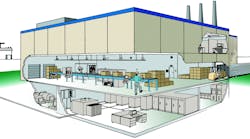With the economy limping along under the weight of credit tightness, a construction slowdown and rising costs, it's been interesting to see the way electrical industry people's perceptions have evolved. There's been a constant undercurrent in the industry over the past 12 months along the lines of, “yeah, the economy stinks, but our company is really not doing all that bad.”
As a reality check, it's useful to look into the financial reports of public companies active in the industry. Due to SEC rules, there has to be some reality to the comments executives make about their companies' recent fortunes and their short-term prospects, and these comments have to be backed by numbers that can bear the scrutiny of current and prospective investors.
With that in mind, Electrical Wholesaling dug into a pile of quarterly statements released over the past couple of months to pull together a variety of perspectives, in the hope that the combined picture will give us a sense of where we are and where we're going. The upshot is that electrical industry executives are looking for growth through the end of 2008 in the low single-digits, and they remain hopeful that their efforts at cost-cutting, refocusing and rebalancing their operational portfolios will put them in a position not only to weather the economic storm but to grow more solidly thereafter. From this perspective, the industry as a whole, it seems, “is really not doing all that bad.” Take a look:
Eaton Corp., Cleveland
NYSE: ETN
Eaton has been enjoying the benefits of diversification and the quick integration of Moeller Group and Phoenixtec into its Electrical segment after their acquisition earlier in the year, says Alexander Cutler, chairman and chief executive officer. “Our businesses performed extremely well in the second quarter, generating strong sales growth and record profits. We were able to achieve these results despite the nearly 40 percent rise in oil prices during the quarter, which caused significant turmoil in our transportation-related end markets. With 20 percent of our revenue from emerging countries and with continued strength in many of our product markets, we believe we are well-positioned to deal with the reduced growth outlook for the U.S. and European economies caused by higher fuel prices.
“Sales growth in the second quarter of 32 percent consisted of 19 percent from acquisitions, 8 percent from organic growth and 5 percent from exchange rates,” Cutler says. “We outgrew our end markets by 2 percentage points, as our end markets grew 6 percent in the quarter. It is also worth noting that 45 percent of our overall segment operating profits were earned by our Electrical segment, reflecting the impact of our recent acquisitions and end markets which are continuing to grow solidly.
On the outlook ahead, Cutler sees the small gains continuing. “As we survey our end markets, the year is shaping up to be slightly weaker than our initial forecast due principally to the impact of higher oil prices in several of our end markets,” he says. “We now anticipate our overall end markets to grow at 3 percent, 1 percentage point lower than our prior forecast. We see growth in our U.S. markets at 1 percent compared to our prior estimate of 2 percent, while our non-U.S. markets are expected to grow 5 percent compared to our prior estimate of 6 percent.”
Second quarter sales for Eaton's Electrical segment were a record $1.94 billion, up 67 percent over 2007. Adjusted for acquisitions, sales grew 14 percent, split between 12 percent organic growth and 2 percent from foreign exchange. Operating profits in the second quarter were $250 million. Excluding acquisition integration charges of $7 million during the quarter, operating profits were $257 million, up 82 percent from results in 2007.
“End markets for our Electrical business grew approximately 5 percent during the second quarter,” said Cutler. “U.S. markets, which make up 40 percent of our electrical sales, grew just under 5 percent in the quarter, and non-U.S. markets grew 5 1/2 percent in the quarter. In addition, our operating margins expanded to a record 13.3 percent, up 1.1 percentage points over the second quarter of 2007.
“Our bookings in the Electrical segment, adjusted for foreign exchange and acquisitions, grew 11 percent over the second quarter of 2007,” said Cutler. “June was particularly strong, with orders increasing 15 percent over June of 2007. We now expect growth in our Electrical markets for all of 2008 to be 5 percent.”
“We received several significant orders during the second quarter, reflecting in part our ability to provide a more comprehensive set of products and services to customers,” said Cutler. “A good example of this is a new contract awarded us by the Federal Aviation Administration for a variety of power quality equipment. The contract is expected to total $40 million over the next 10 years.”
Hubbell Inc., Orange, Conn.
NYSE: HUBB
“We are very pleased with our second quarter results; this marks the sixth consecutive quarter with year-over-year operating profit margin improvement,” says Timothy Powers, chairman, president, and chief executive officer. “Our strong second-quarter profit performance has benefited from ongoing execution in price realization, cost management and productivity, this in spite of the continuing rise in commodity costs. We were able to effectively manage these increases largely through higher selling prices, which contributed approximately 2 percent to sales growth and productivity improvements.”
“The overall economic environments we operate in are generally performing as anticipated,” Powers adds. “The U.S. economy continues to be impacted by the ongoing credit crisis, housing market weakness and increasing energy costs. International markets remained strong — particularly energy related, mining and high-voltage test equipment markets, while U.S. non-residential construction and industrial maintenance and repair have slowed. Markets served by Hubbell's Power segment expanded with growth in transmission products and modest demand for distribution voltage products that continue to be impacted by the residential market decline.”
Hubbell's Electrical group's net sales improved 5 percent year-over-year as the impact of its acquisition of spec-grade lighting manufacturer Kurt Versen in January and overall selling price increases more than offset weaker residential product sales, the company says. Sales of wiring products were up slightly compared to last year due to favorable foreign currency translation and increased demand for energy management controls and sensors. Continued strong demand led to higher sales of products for harsh and hazardous locations and for high-voltage instrumentation products. Residential lighting sales were 23 percent lower than the same period in 2007, due to continued weakness in this market. Electrical segment operating profit increased 19 percent compared to the second quarter of 2007. The improved profitability in the segment was due to the lighting acquisition, productivity improvements and higher selling prices, the company says. The weaker results in residential lighting negatively impacted the segment's operating profit margin by approximately 50 basis points.
On the short-term future, Powers expects slow growth in most sectors. “We anticipate the continuation of current trends in the overall markets for the second half of the year,” he says. “Hubbell's largest market, non-residential construction, is forecasted to grow at a lower rate in the second half of 2008 compared to the first half. The utility market is expected to expand, with growth in transmission and substation spending while distribution investments are likely to be modest. We expect continued growth for the remainder of this year in the industrial markets that we serve. The residential market is expected to decline in 2008 at a rate at least consistent with 2007 with no improvement in our residential business likely for the remainder of this year.”
Acuity Brands, Atlanta
NYSE: AYI
Acuity Brands reported record results for the third quarter of fiscal 2008. Income from continuing operations for the quarter rose 21 percent to $41.7 million compared with $34.3 million for the prior year third quarter. The company generated record third quarter net sales of $512.4 million, a 2 percent increase over $502.4 million reported in the year-ago period.
The year-over-year increase in net sales reflects more favorable pricing and an enhanced mix of products sold, highlighted by greater shipments of proprietary energy-efficient fixtures for new construction and the relighting of existing non-residential buildings, the company said.
“Looking ahead, various leading indicators such as employment, housing demand, consumer sentiment, bank lending standards, and commodity prices are signaling a slowdown in future non-residential construction activity, our primary market,” said Vernon Nagel, Acuity Brands' chairman, president and chief executive. “Accordingly, we anticipate unit sales growth to be challenging for the remainder of fiscal year 2008 and into 2009. The company's backlog at May 31, 2008 was approximately $182 million, down 4 percent compared with the prior year. While positive factors such as a decline in past-due orders and reduced lead times resulting from our improved delivery performance contributed to this decline, we have experienced modest softness in incoming orders over the past couple of months and expect them to remain soft for the foreseeable future. In addition, we expect to experience pressure on gross margins in the fourth quarter as a result of significant increases in commodity costs such as steel, aluminum, plastics and copper as well as higher freight costs due to the significant rise in the price of diesel fuel.”
“We also see growth opportunities by furthering our market presence, such as our expansion into the New York City metropolitan area where we have historically had limited participation in this large and dynamic market,” Nagel added.
Cooper Industries Ltd., Houston
NYSE: CBE
Cooper Industries reported that second quarter 2008 revenues increased 18 percent to $1.72 billion, compared with $1.46 billion for the same period last year. Net income excluding unusual items rose 18 percent to $171.1 million, compared with $145.1 million for the prior year's second quarter excluding unusual items.
“In the second quarter, we built on our very solid start to 2008. We delivered strong growth in developing markets as well as in our energy, utility and industrial businesses. Core revenue growth of 7 percent was supplemented by acquisitions, which contributed nearly 8 percent, as well as almost 3 percent from currency translation,” said Cooper Industries Chairman and Chief Executive Officer Kirk Hachigian.
Revenues in the company's Electrical Products segment for the second quarter increased 19 percent to $1.51 billion, compared with $1.27 billion in the second quarter 2007. Segment operating earnings were $259.0 million, an increase of approximately 21 percent from $213.9 million in the prior year's second quarter. Segment operating margin improved 40 basis points to 17.2 percent for the second quarter of 2008.
The increase in revenues for the Electrical Products segment reflects continued strength in the industrial, utility and energy markets, with international market initiatives providing further growth for the second quarter of 2008, the company said. The continued softness in the U.S. residential markets partially offset the segment's overall revenue growth.
Rockwell Automation Inc., Milwaukee
NYSE: ROK
Keith Nosbusch, Rockwell Automation's chairman and chief executive officer, said, “We delivered solid top line results despite slower than expected growth in Europe and the U.S. Revenue growth was particularly strong in Asia-Pacific, Latin America and our solutions businesses, demonstrating strength in the on-going diversification of our revenue base. Operating margins and earnings per share (EPS) grew sequentially but came in lower than 2007, largely driven by continued slower growth in our higher margin product businesses. Given the current environment, we are proactively implementing the appropriate actions to control costs.”
The look ahead is none too rosy, at least for the rest of the year. “For the remainder of the fiscal year we expect to see continued strength in Asia-Pacific and Latin America as well as in resource-based industries. However, macro-economic conditions in Europe and the U.S. are weakening. We have begun to see a change in buying behavior by some of our customers in consumer-related industries, including project delays and curtailed capital spending.
“We continue to monitor market conditions with a view toward rebalancing spending, as well as positioning ourselves to address a potential contraction, should it materialize. We remain committed to executing our growth and performance strategy, including continued investment in core technologies and the globalization of our business.”
Schneider Electric S.A., Paris
PARIS: SU.PA
France-based electrical manufacturer Schneider Electric has weathered the financial downturn well, thanks to an earlier program to emphasize business fundamentals. “The first-half of 2008 marks another breakthrough in the financial performance of Schneider Electric,” says Jean-Pascal Tricoire, president and CEO. “We are also on track to exceed all targets of our new company program, in terms of customer service, growth, productivity, rebalancing and other efficiency plans.
“We are translating our unique position of global specialist in energy management into sustained growth, enhanced profit and accelerated cash generation. For 2008, we are revising upward our guidance and plan a minimum 8 percent organic sales growth and 15 percent EBITA (earnings before interest, taxes and amortization) margin. Looking ahead, we shall demonstrate in our next company program to start in 2009 new ambitions and significant opportunities of further progress.”
Schneider Electric's sales in North America grew 4.7 percent, a low figure it attributed to the impact of supply chain issues, plus strong growth in the previous year period that makes comparison a challenge. The company made up for the softening of demand in some segments thanks to its new businesses of building automation and critical power and to its targeting of attractive market segments in energy, infrastructure and construction.








